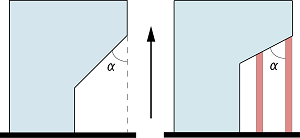About ALM Overhang Controls | ||||
|
| |||
An overhang control assists in producing an optimized shape that can be created using an additive manufacturing process (3D printing). Overhang in additive manufacturing is the extent to which the part or layers can be unsupported by the build tray or by previous layers. The allowed overhang varies based on the process and materials in use, along with the shape you are producing.
Overhang Angle
The angle within an overhang control enforces an optimized design that does not exceed the specified maximum overhang angle as measured from the vertical axis of the printing direction.
If you do not control the overhang angle, the optimized design might have too large an overhang angle. This requires additional support structures to print the part. Support structures are unavoidable in some designs, but they add printing time and material, and they require a postprocessing operation to remove.
The design on the left has an overhang angle,
, that is within printing capabilities. The angle in the design on the
right exceeds the maximum overhang angle and would require supports (shown in red) to print.

Preserved Regions
Preserved regions are not changed in the optimization process. However, optimizing the
areas surrounding a preserved region can lead to overhangs. You can use overhang controls to
prevent overhangs below preserved regions. The design on the left did not use overhang
control for preserved regions. The preserved center section in dark gray is unsupported. The
design on the right was optimized using a control to retain support under the preserved
region.
Reference Planes
If you specify the print bed as the reference plane, the shape optimization avoids shapes that require support structures to that plane. However, some designs require overhanging regions. If you specify design space boundaries as reference planes, the optimization can account for multiple planes while respecting the other overhang options.
For example, the design on the left uses a single reference place, the print bed. Withiout
adding supports there is no way to produce a part that extends into the white outlined area
of the design space. By specifying a second reference plane, the optimized design on the
right includes supports and extends to the rest of the design space. 